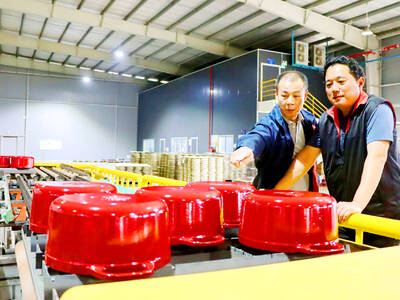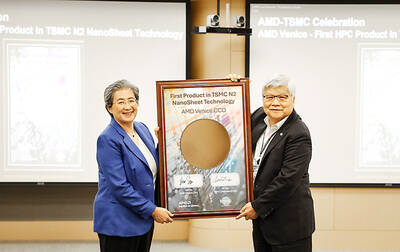An amateur photographer who goes by the name “ibreakphotos” decided to do an experiment on his Samsung smartphone last month to find out how a feature called “space zoom” actually works.
The feature, first released in 2020, claims a 100x zoom rate, and Samsung Electronics Co used sparkling clear images of the moon in its marketing.
Ibreakphotos took his own pictures of the moon — blurry and without detail — and watched as his phone added craters and other details.

Photo: AFP / Jos Avery
The phone’s artificial intelligence (AI) software was using data from its “training” on many other pictures of the moon to add detail where there was none.
“The moon pictures from Samsung are fake,” he wrote, leading many to wonder whether the shots people take are really theirs anymore — or if they can even be described as photographs.
Samsung has defended the technology, saying it does not “overlay” images, and pointed out that users can switch off the function.
The firm is not alone in the race to pack its smartphone cameras with AI — Google’s Pixel devices and Apple Inc’s iPhone have been marketing such features since 2016.
The AI can do all the things photographers used to labor over — tweaking the lighting, blurring backgrounds, sharpening eyes — without the user ever knowing.
However, it can also transform backgrounds or simply wipe away people from the image entirely.
The debate over AI is not limited to hobbyists on message boards — professional bodies are raising the alarm too.
The industry is awash with AI, from cameras to software like Photoshop, said Michael Pritchard, director of education and public affairs at the Royal Photographic Society of Britain.
“This automation is increasingly blurring boundaries between a photograph and a piece of artwork,” he said.
The nature of AI is different to previous innovations, because the technology can learn and bring new elements beyond those recorded by film or sensor, he said.
This brings opportunities, but also “fundamental challenges around redefining what photography is, and how ‘real’ a photograph is,” Pritchard said.
Nick Dunmur of the Britain-based Association of Photographers said professionals most often use “RAW” files on their digital cameras, which capture images with as little processing as possible.
However, sidestepping the technology is less easy for a casual smartphone shooter.
Ibreakphotos, who posted his finding on Reddit, said that technical jargon around AI is not always easy to understand — perhaps deliberately so.
“I wouldn’t say that I am happy with the use of AI in cameras, but I am OK with it as long as it is communicated clearly what each processing pipeline actually does,” he told reporters, asking not to use his real name.
What professional photographers are most concerned about, though, is the rise of AI tools that generate completely new images.
In the past year, DALL-E 2, Midjourney and Stable Diffusion have exploded in popularity thanks to their ability to create images in hundreds of styles with just a short text prompt.
“This is not human-authored work,” Dunmur said. “And in many cases is based on the use of training datasets of unlicensed work.”
These issues have already led to court cases in the US and Europe.
According to Pritchard, the tools risk disrupting the work of anyone “from photographers, to models, to retouchers and art directors.”
However, Jos Avery, a US amateur photographer who recently tricked thousands on Instagram by filling his feed with stunning portraits he had created with Midjourney, disagreed.
He said the lines drawn between “our work” and “the tool’s work” were arbitrary, pointing out that his Midjourney images often took many hours to create.
However, there is broad agreement on one fundamental aspect of the debate — the risk for photography is not existential.
“AI will not be the death of photography,” Avery said.
Pritchard agreed, saying that photography had endured from the daguerreotype to the digital era, and photographers had always risen to technical challenges.
That process would continue even in a world awash with AI-generated images, he said.
“The photographer will bring a deeper understanding to the resulting image even if they haven’t directly photographed it,” he said.

UNCERTAINTY: Innolux activated a stringent supply chain management mechanism, as it did during the COVID-19 pandemic, to ensure optimal inventory levels for customers Flat-panel display makers AUO Corp (友達) and Innolux Corp (群創) yesterday said that about 12 to 20 percent of their display business is at risk of potential US tariffs and that they would relocate production or shipment destinations to mitigate the levies’ effects. US tariffs would have a direct impact of US$200 million on AUO’s revenue, company chairman Paul Peng (彭雙浪) told reporters on the sidelines of the Touch Taiwan trade show in Taipei yesterday. That would make up about 12 percent of the company’s overall revenue. To cope with the tariff uncertainty, AUO plans to allocate its production to manufacturing facilities in

Taiwan will prioritize the development of silicon photonics by taking advantage of its strength in the semiconductor industry to build another shield to protect the local economy, National Development Council (NDC) Minister Paul Liu (劉鏡清) said yesterday. Speaking at a meeting of the legislature’s Economics Committee, Liu said Taiwan already has the artificial intelligence (AI) industry as a shield, after the semiconductor industry, to safeguard the country, and is looking at new unique fields to build more economic shields. While Taiwan will further strengthen its existing shields, over the longer term, the country is determined to focus on such potential segments as

TAKING STOCK: A Taiwanese cookware firm in Vietnam urged customers to assess inventory or place orders early so shipments can reach the US while tariffs are paused Taiwanese businesses in Vietnam are exploring alternatives after the White House imposed a 46 percent import duty on Vietnamese goods, following US President Donald Trump’s announcement of “reciprocal” tariffs on the US’ trading partners. Lo Shih-liang (羅世良), chairman of Brico Industry Co (裕茂工業), a Taiwanese company that manufactures cast iron cookware and stove components in Vietnam, said that more than 40 percent of his business was tied to the US market, describing the constant US policy shifts as an emotional roller coaster. “I work during the day and stay up all night watching the news. I’ve been following US news until 3am

COLLABORATION: Given Taiwan’s key position in global supply chains, the US firm is discussing strategies with local partners and clients to deal with global uncertainties Advanced Micro Devices Inc (AMD) yesterday said it is meeting with local ecosystem partners, including Taiwan Semiconductor Manufacturing Co (TSMC, 台積電), to discuss strategies, including long-term manufacturing, to navigate uncertainties such as US tariffs, as Taiwan occupies an important position in global supply chains. AMD chief executive officer Lisa Su (蘇姿丰) told reporters that Taiwan is an important part of the chip designer’s ecosystem and she is discussing with partners and customers in Taiwan to forge strong collaborations on different areas during this critical period. AMD has just become the first artificial-intelligence (AI) server chip customer of TSMC to utilize its advanced